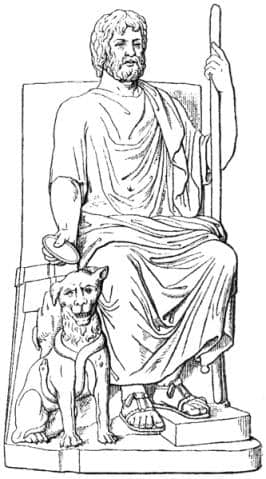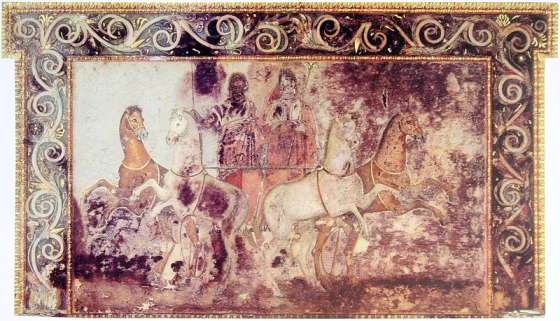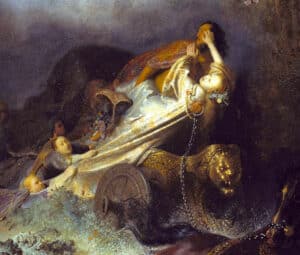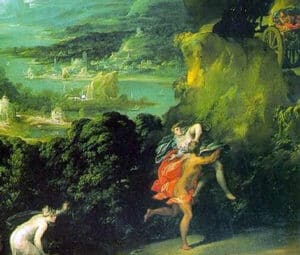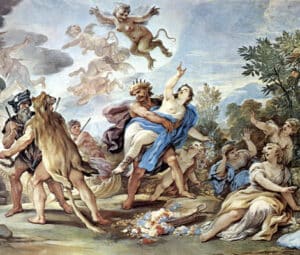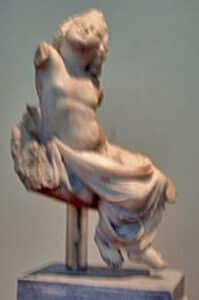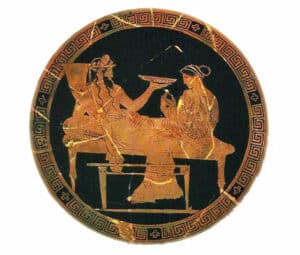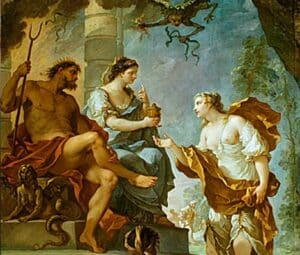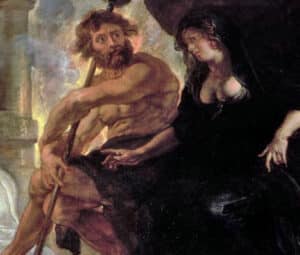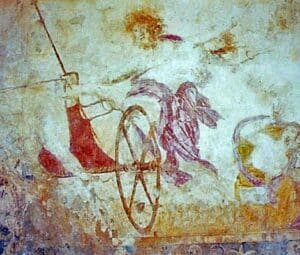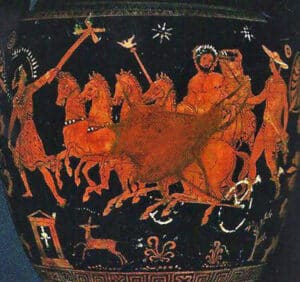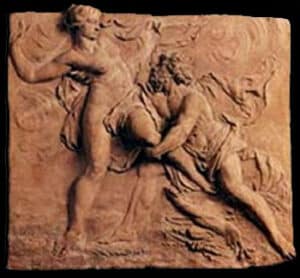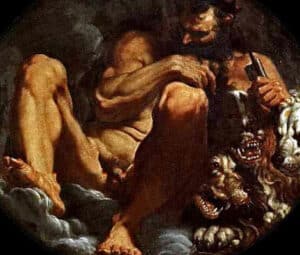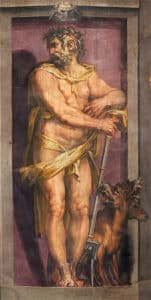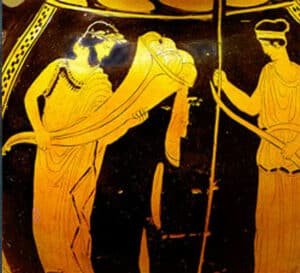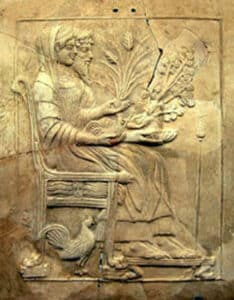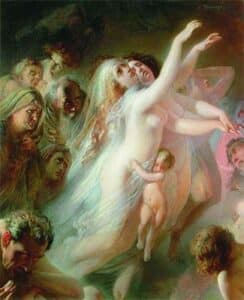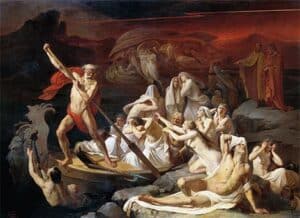One of the three major Gods of the Greek Pantheon, Hades is the God of the Underworld and the dead. While originally the name Hades / Haides was used to describe the God, it then went on to also describe the final destination of the dead, the Underworld. His main symbols are his helm, which made whoever wore it invisible, his scepter, the cornucopia, and his dog, Cerberus. Interestingly, while being a brother of Zeus and the other major Olympian gods and goddesses, he is not always counted among the core Olympian gods.
Key Facts
Family tree
| Parents | Cronus and Rhea |
| Partner(s) | Persephone, The Enigmatic Queen of the Underworld, Minthe, Leuce |
| Siblings | Zeus, Poseidon, Hera, Demeter, Hestia, the virgin goddess of the hearth, Chiron |
| Offspring | The Erinyes, Zagreus, Minor Deity and Son of Zeus, Melinoe, Makaria |
Names & Others
| Roman Name | Pluto |
| Other Names | Plouton (the wealth-giver), Haides |
| Ancient Greek | ᾍδης |
| The God of | Underworld, the dead, dreams, funeral rites, the curse of the Erinyes, necromancy |
| Symbols | Cerberus, cornucopia, royal scepter, helm, Narcissus, The Handsome Boy In Love With Himself, cypress tree, keys |
Name and Etymology
There have been many attempts to define the etymology of the name Hades. The most common etymology links to the Greek compound word α + Fιδ-, ά-ίδης, meaning “the invisible, the unseen”.
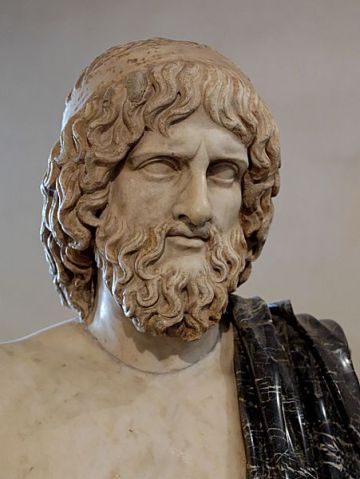
There has also been an extensive argument in Plato’s “Cratylus”, where Socrates says that the name comes from the word ειδέναι (eidenai), meaning “to know, to understand”, because he knows all the virtuous things. Plato also confirmed this etymology in his “Republic”, saying that the soul in the underworld understands (= eidenai) the divine. This argument, however, seems to be highly improbable.
An interesting fact is that, during the Classic Age in Greece, people did not call him Hades, but Plouton. Plouton derives from «πλούτων», which means the wealth-giver and refers to the riches of the soil. The Romans used this name directly for God, turning it into Pluto. From then on, the name “Hades” would be used only to mean the underworld.
To avoid calling him by his name, many Greeks also called him Underworld Zeus / Zeus Katacthonios.
Hades’ Origins and Family
Hades was the son of the Titans Cronus and Rhea. Cronus dethroned his father, Ouranos, and he reigned in the Heavens. Fearful that his children would do the same to him, he swallowed them all. Rhea managed at the last moment to save Zeus from his father, by giving Cronus to eat a swaddled rock.
The escaped Zeus returned and made his father cough up his siblings. In this way, Zeus saved Hades together with Poseidon, Hera, Demeter, and Hestia. In an act of revenge, the six siblings with some allies tried to overthrow the Titans and take their place in the Heavens. This led to Titanomachy, the ten-year battle between the Olympians and the Titans.
Hades, Zeus, and Poseidon each got their weapons from the Cyclops. Hades got his infamous helmet, which turned anyone who wore it invisible. The Olympian Gods won the battle and imprisoned the Titans in Tartarus, the deepest part of the Underworld.
Following their triumph, Hades and his two younger siblings, Poseidon and Zeus, drew lots to decide whose kingdoms they would govern.
Zeus presided over the sky, Poseidon over the oceans and every liquid element, and Hades over the Underworld, the invisible realm to which the dead travel when they perish.
Hades’ Lovers
Hades’ love life was simple and well-known. Apart from two Nymphs that were said to have a short affair with the God, his heart was set on Persephone, the daughter of Demeter.
Hades and Persephone – The Abduction
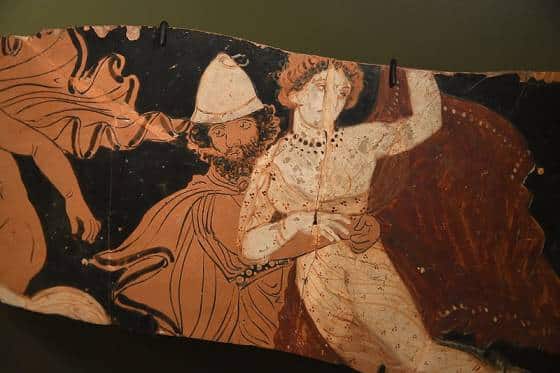
Persephone was the only daughter of Demeter and Zeus and as such, Poseidon’s niece. She was described as a fair-skinned young lady, with dark hair and deep dark eyes. Upon seeing her, Hades fell instantly in love with her and wanted to wed her.
According to the Homeric Hymn to Demeter, Persephone was gathering flowers at the Nysian Plains. She was in the company of Athena, Artemis, and the Oceanids. Hades tricked the young girl by creating the most beautiful flower ever to exist. It had a hundred little blooms, and its fragrance made the Heavens fill with joy.
When Persephone reached to touch the flower, the ground split apart beneath her feet, and Hades abducted her on his golden chariot. No one could hear her cries, not even Zeus. Only Hecate, the goddess of magic, and the Sun himself heard the young girl. After that, Persephone unwillingly became the Queen of the Underworld.
Hades and Persephone – Change of Seasons
Demeter had been frantically searching for her daughter for nine days and nights, without eating or drinking. On the tenth day, she encountered Hecate, who told her what had happened. They both went to meet the Sun, who replied that it is Zeus’ fault, who let Hades take his daughter without her will. Despite his attempts to reassure her, she was livid with Zeus. She pledged never to set foot on Olympus again unless her daughter returned to her. She stayed on Eleusis, and she threatened to bring famine to the humans.
When he learned of this, Zeus sent Hermes to talk to Hades. He gave him Zeus’ orders and explain what Demeter was threatening to do. He let Persephone go but promised her that if she stayed with him, she would rule over everything and be very powerful. The young girl hastily rose to return to her mother, but Hades gave her six pomegranate seeds in secret.
When Persephone returned to her mother, Demeter asked her if she had eaten anything in the underworld. Anyone who consumes something in the Underworld must return there. Persephone told her mother about the pomegranate seeds. They had no choice but to make a deal: Persephone would spend six months in the underworld (one for each seed she ate), and six months with her mother. When Persephone visits the upper world, the ground is fertile (spring and summer), whereas when she returns to the world of the dead, the opposite occurs (autumn and winter).
Hades and the Nymphs
Hades, like his brother Zeus and the other Greek gods, was not the most devoted husband. He pursued and fell in love with the nymph Minthe. To punish her, his envious wife Persephone transformed Minthe into the plant mint. Similarly, he kidnapped the nymph Leuke and transformed her into a white poplar after her death, the trees commonly found near Acheron, the river leading to the Gates of the Underworld
Hades’ Offspring
Legend says that Hades was infertile, which would suit his place as the God of the dead. However, some sources tell of some children.
Macaria
The Byzantine Encyclopedia of Suda tells that Macaria was the daughter of Hades and she was the embodiment of the blessed death. Not to be confused with Macaria, the daughter of Hercules, who was sacrificed to Persephone.
Melinoe
Melinoe, according to an Orphic Hymn, was a chthonic nymph, usually related to Hecate. She was the bringer of madness and nightmares. According to the hymn, she was the daughter of Persephone and Zeus. The Orphics believed that Zeus and Hades were two representations of the same deity.
Zagreus
Zagreus was for the Orphics the son of Persephone and Zeus, characterized as the “first Dionysus, the god of wine and revelry”. Aeschylus mentions that Zagreus was the son of Hades or even Hades himself.
The Erinyes
Erinyes were the deities of vengeance. While considered the daughters of Nyx, the Night herself, in Roman accounts they are told to be the daughters of Hades and Nyx. Also, the Orphics considered them to be the daughters of Hades and Persephone.
Depiction and Characteristics
As the king of the dead, Hades carries great symbolism and is equipped with different symbols and weapons. Gathering from many sources, we can make a rough estimation of what he looked like, but we know a lot about his personality and powers.
Hades’ Appearance
Hades, in contrast to his brothers Zeus and Poseidon, was rarely depicted in art. Even authors and mythologists refrained from describing him in any way.
His appearance seems to resemble that of his brothers: fierce, tall, and powerful. He does, however, have long dark hair that falls down his brow and a thick beard. He was depicted as younger than the other two Gods. He is frequently shown as a gloomy and dark person with a solemn expression.
Hades is frequently represented with his scepter (a bident), sacred helm, cornucopia, and keys to the Gates of the Underworld in his hands. Cerberus, his three-headed dog, usually sat beside him.
Hades’ Personality
We don’t know much about Hades’ personality, just like we don’t know much about his appearance. Because they did not wish to attract Hades’ attention, Greeks normally refrained from thinking about what he looked like or what he was like.
From various sources, we can assume that he was not genuinely evil, but rather a more passive and maybe benign figure. He was in charge of maintaining the equilibrium between the mortal world and the underworld. Hades was also considered to be austere and strict, holding everyone who resided in the underworld accountable.
The god of the dead did not favor anyone. He was wrathful and vengeful towards any human who tried to flee the underworld or trick death in any way.
Hades’ Powers
Being one of the three sons of Cronus, Hades was a regal God with enormous power. He had superhuman strength and stamina, and he was immortal, invulnerable, and omnipresent – even if he was unconcerned with what happened in Olympus or the mortal world.
Apart from his common abilities with the other Gods, as Lord of the Underworld, he had complete power over the underworld, darkness, and the dead. He could manipulate wealth since he was also the king of riches, and he had control over all the riches that came from the Earth’s soil. Hades / Pluto is thought to be the wealthiest of all Gods.
He was also in possession of the Cyclops’ helm. This granted him the ability to become invisible and intangible. When used on another person, it could cause intense dread and fear, which could lead to insanity.
Hades’ Sacred Symbols
The main sacred symbol of Hades was the helm given to him by the Cyclops, which rendered anyone invisible. Hesiod in his “Shield of Heracles” (226-228), describes the cap of darkness on the head of Perseus, The Legendary Slayer of Medusa as having “νυκτὸς ζόφον αἰνὸν”, meaning the dreadful gloom of the night.
He also held his royal scepter in his hands. Hades could use it to shatter the ground and create a passage between the underworld and the mortal world. He also kept the golden keys to the Underworld’s gates. In addition, as the wealth-giver of the Earth, his symbol was a cornucopia, the horn of plenty.
On his sacred estate, we can also find his golden chariot of four immortal, ebony horses. His palace was at the depths of the Underworld, and his throne was in the center of the hall. Minos, Rhadamanthus, and Aeacus, the three judges of the dead, sat atop his golden throne.
Hades’ Sacred Animals / Plants
In his yard, Hades had a sacred orchard with pomegranates, the same fruit he used to deceive Persephone into staying with him. Other sacred plants of Hades include mint and white poplar, the representations of the nymphs Minthe and Leuke. Another sacred plant is the cypress tree, which is still regarded as the tree of mourning today.
In the myth of Narcissus, Hades is also associated with narcissus flowers. Persephone picks up this plant on her route to the Underworld. The narcissi could even be daffodils (or asphodels), the sacred flower of Hermes and the flower of grief that grows in the Elysian meadows. The Greeks sowed it around graves to nourish the souls of the deceased.
His most sacred animal is Cerberus, his three-headed guardian dog. Other animals include his cattle, his ebony horses, and serpents.
The screech owl was also sacred to Hades. It was a bird bearing bad omens and it was believed to be Askalaphos, Hades’ orchardist. In myth, Askalaphos told Demeter that Persephone had eaten the pomegranate. She was so angry that she buried him under a rock. When Heracles released him, Demeter, still enraged, transformed him into a screech owl.
Roles and Responsibilities
Following the Titanomachy, Hades was designated the God of the Underworld. Zeus ruled over the skies, Poseidon ruled over the seas, and the primordial Gaia ruled over the Earth.
Hades ruled his domain with enormous power. He never left Hades (=Underworld), which bears his name. He usually spent his time in the rivers Acheron, Lethe, Styx, The Goddess of the Underworld River, Phlegethon, and Cocytus, which connected the mortal world to the Underworld.
He also ruled over the dead, aided by demons under his absolute control. He fiercely banned his subjects from leaving his realm and became infuriated if anyone sought to flee, resurrect, or seize what was his. The god mainly interacted with creatures and people in the Underworld, not with the other Gods or humans. He was close to his dog, Cerberus, his wife, Persephone, and Charon, The Solemn Ferryman of the Underworld, the driver of the ferry that transported souls to the Underground via the Styx River.
Hades was not, according to popular belief, the god of Death. Thanatos was the god of Death, and he acted under the rulings of the Fates. Hades was however, the lord of the underworld, as well as the overseer of mortals and immortals. He made certain that no one who died could return to the mortal realm or deceive death in any way. He appears delighted with his position as King of the Underworld.
Furthermore, he was also the God of the funeral rites. A human could not enter the underworld if they did not have the required ceremony, as Sophocles describes in his tragedy “Antigone.”
Hades was also the master of dreams and the deity of necromancy and curses. People worshipped him as the deity of the earth’s prosperity and fertility, as well as mining and anything derived from its soil.
Myths About Hades
The most well-known myth about Hades is the myth of Persephone, as described above. He is also linked to the Titanomachy, the nymphs Leuke and Minthe, and Askalaphos. He was also linked to other myths in Greek Mythology, concerning mostly mortals.
Orpheus And Eurydice
Orpheus was a young hero who entered the Underworld to save his wife Eurydice, who had died because of serpent poison. The melody Orpheus played on his lyre enchanted Hades, who for the first time allowed a mortal to bring a loved one back to life. He agreed to do so on the condition that Orpheus does not peek back at her until they both entered the mortal world. According to the myth, Orpheus looked back at Eurydice, causing her to vanish forever.
Theseus And Pirithous
Following the deaths of both of their spouses, Theseus and Pirithous made a vow to kidnap and marry two of Zeus’ daughters. While Theseus chose Helen of Sparta, Pirithous chose Persephone herself. Hades was aware of their plot, so when they arrived in the Underworld, he organized a fake feast. Rocks fell and entrapped both men.
Heracles was able to free Theseus, but Pirithous remained imprisoned because he had committed a far more heinous act. Aristophanes claims that Euripides reported Pirithous being fed to Cerberus.
Sisyphus
Sisyphus, the ruler of Corinth, revealed to the river god Asopus where Zeus held his daughter Aegina. Zeus ordered Thanatos to kill Sisyphus as a punishment. Thanatos was cleverly ensnared by Sisyphus, and only Ares, the god of war could free him. No mortal could perish until Sisyphus released Thanatos, the god of death.
Sisyphus told his wife, Merope, not to perform the burial rites after Hades kills him. That was deemed a disruption of the tribute to the Underworld On the condition that he would return, Hades allowed Sisyphus to return to the above world and punish his wife. Sisyphus, however, did not obey the command.
When Sisyphus eventually died of old age, Hades punished him severely. He gave him the task of rolling a boulder up a hill. When the boulder reached the summit, it would roll back down, forcing Sisyphus to push it up again. That loop would last for all eternity.
Heracles
We can find the mention of Hades in many of Heracles’ stories. During his final labor, Heracles had to go into the underworld and take Cerberus. After Athena and Hermes helped him find the way in and out of the Underworld, Heracles went and asked Hades if he could take Cerberus. He agreed as long as the dog remained alive and unharmed.
In another myth, Alcestis, The Woman Of Sacrifice wanted to die so that her husband, Admetus, could stay alive. Heracles went and saved Alcestis either by fighting Thanatos or Hades himself. Heracles also supposedly harmed him during the siege of Pylos, and Hades had to be healed by Paean, the physician of the gods.
Coronides
Following the war of Thebes, King Creon refused to provide proper burial rituals for the enemy’s fallen warriors. As a result, Hades and Persephone caused famine and plague in Thebes. The two Coronides and Orion’s daughters, Metioche and Menippe, sacrificed themselves to save their homeland. Hades and Persephone admired them for their self-sacrifice and turned them into comets.
Asclepius
The wrath of Hades struck Asclepius, the god of medicine. Asclepius was healing more and more mortals, saving them from dying. As the number of the dead decreased, Hades accused Asclepius before Zeus of disrupting his realm. Zeus struck Asclepius with his thunderbolt to right his brother.
Hades in Ancient Greek Religion
In the ancient world, Hades had only a few sacred sites and shrines. The Greeks worshipped him through burial rituals and necromantic mysteries. The Nekromanteion, built on the banks of the river Acheron, was the most well-known of his temples. He also had temples in Athens, Olympia, and Elis.
Worship & Festivals
Greeks feared Hades, so much they even refrained from calling him by name. Thus, he was not extensively worshipped. He was generally worshiped alongside the other chthonic deities (Persephone, Hecate, Charon, and all spirits of the underworld and the dead). Plain attire, sacrifices over caves and chasms, and usually lamentations were part of these rites.
The Chthonia was the only known festival for Hades, where people worshipped all chthonic deities by planting seeds and conducting mysterious rites. There was also a ceremonial reenactment of Persephone’s abduction in Syracuse, close to Kyane spring. Pilgrimages to the Nekromanteion in Acheron were common.
Try The Hades Quiz
After everything you have learned about Hades, are you ready to test your knowledge?
You can also play around with Hades’ and other Olympian gods’ names in this fun anagram game:
If you liked these games, don’t forget to try out other games as well! For example, this “match the couples” game!
Representations of Hades in Art
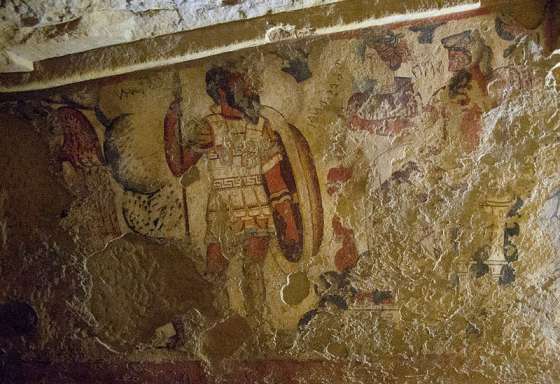
Hades is not commonly depicted in classic artwork due to his harsh and dreadful nature. He never appears between the other Olympians. Only a few pieces of archaic earthenware portray him. A 5th-century B.C. red-figure vase housed in the National Archeological Museum in Athens depicts him with Demeter, assisting her in sowing a field. A terra-cotta plaque from the same era depicts Hades and Persephone as underworld rulers sitting side by side. He is depicted with Persephone watching the Furies as they bound Pirithous and Theseus in a vase from the fourth century B.C.
We can mostly see him in portrayals of Persephone’s abduction, such as Gian Lorenzo Bernini’s baroque marble sculpture. From these depictions, we gather the majority of his physical attributes. He is represented more favorably as Pluto, holding cornucopias and bringing wealth and fertility.
In The Old Texts
Hades was rarely discussed or mentioned in ancient Greek literature. He appears mostly in Hesiod’s historical works, where we observe his role in the Titanomachy, as well as his appointment and dominion over the underworld. Homer briefly mentions him in Iliad and Odyssey.
Most of the material about Persephone’s abduction comes from the Orphic Hymns. In addition, various tragedies and comedies by Aeschylus and Aristophanes describe his blending in typical Greek mythological tales.
Ovid, Cicero, and Seneca portray him more positively. Ovid, in particular, tells us of about his lovers in his Metamorphoses, and we learn about Hades’ birth and role in the cosmos in his Fasti.
FAQs
Hades was the god of the underworld, the dead, and the wealth of the Earth.
It was the name of both the god and the underworld.
Hades’ parents were Cronus and Rhea.
He had three brothers and sisters: Hestia, Poseidon, Hera, Zeus, Demeter, and Chiron, The Wise Centaur.
He possibly had no children. He is told to be the father of the Erinyes, Zagreus, Melinoe, and Makaria
Lovestruck, he abducted Persephone to have as his wife.
His helmet
The Norse Goddess of the underworld Hel.
Sources
Aeschylus
- Eumenides
- Fragment 124 Sisyphus
Antoninus Liberalis
- Metamorphoses 25
Cicero
- De Natura Deorum 2. 26
Diodorus Siculus
- Library of History 4
Hesiod
- Shield of Heracles 226-228
- Works and Days 465
- Iliad 5. 382
- Iliad 9. 450
- Odyssey 24
- Hymn 2 to Demeter
Orphic Hymns
- 18 to Pluton
- 70 to the Eumenides
- 71 to Melinoe
- 70 to the Furies
Ovid
- Metamorphoses 10. 728
- Metamorphoses 5. 534
Pindar
- Olympian Ode 9
Plutarch
- Life of Theseus 31.2
Pseudo-Apollodorus
- Bibliotheca 1. 29
- Bibliotheca 2.
Statius
- Thebaid 12
Suidas
- s.v. Makariai
Valerius Flaccus
Virgil’s
- Eclogues 4. 250
Featured Image Credit: Louvre Museum, CC BY 3.0, via Wikimedia Commons

